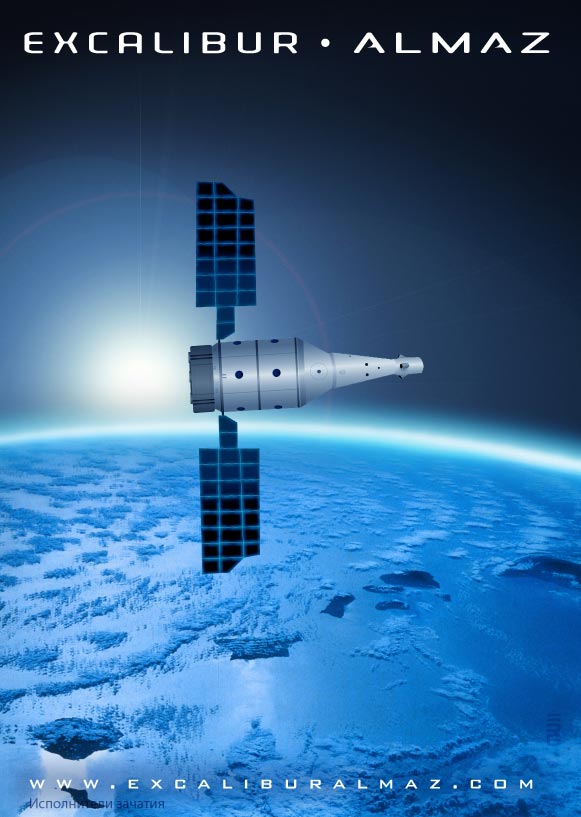Soviet-Era Spaceships to Fly Commercial Space Missions

This story was updated at 7:30 p.m. EDT.
An international spaceflight company plans to launch paying passengers on week-long orbital trips by 2013 using vehicles based on Soviet-era spacecraft built for classifed military space stations.
The company, Excalibur Almaz Limited based in the Isle of Man, has acquired several Reusable Return Vehicles (RRVs), spacecraft initially designed for flying cosmonauts to the former Soviet Union's super-secret Almaz space stations of the 1970s, the firm announced Tuesday at the Moscow Air Show in Russia.
"With this announcement, the dream of private orbital space exploration may become a reality in the very near future," said veteran Russian cosmonaut Vladimir Titov, an advisor to Excalibur Almaz, in a statement.
To date, wealthy space enthusiasts have been able to book trips to orbit by riding as paying passengers on Russia's Soyuz spacecraft headed for the International Space Station during crew change missions. Those trips, arranged by the Virginia-based firm Space Adventures and Russia's Federal Space Agency, currently cost more than $30 million.
Excalibur Almaz did not reveal its anticipated price per trip in Tuesday's announcement, but did detail plans to update the RRV spacecraft design with modern technology to support independent flights to orbit.
The spacecraft consists of two sections, the cone-shaped RRV for launch and re-entry, and an expendable service module designed to offer more room to live and work in space. The vehicles can carry three people — a commander and two passengers — or about 1,100 pounds (500 kilograms) of cargo and are designed to stay aloft for at least a week, officials said.
Get the Space.com Newsletter
Breaking space news, the latest updates on rocket launches, skywatching events and more!
"A critical feature of the RRVs is their reusability, which will reduce logistical, overhead and program costs for commercial access to space," Excalibur Almaz officials said, adding that the spacecraft will be designed to fit atop a variety of launch vehicles in order to lift off from different sites around the world.
The company is working with the original Almaz station manufacturer, Russia's NPO Mashinostroyenia (or NPOM), to overhaul its stock of launch vehicles and space stations, company officials said. The spacecraft will be updated to meet customer needs for space exploration, cargo delivery or orbital research in microgravity, they added.
NPOM designed, tested and flew several Almaz space stations and RRV prototypes in the 1970s. The first Almaz (which means "Diamond" in Russian) station to reach orbit was christened Salyut 2, but failed in 1973. Two others, dubbed Salyuts 3 and 5, later flew with much success. The RRVs flew about nine test flights, with two vehicles reaching orbit repeatedly, Excalibur Almaz officials said.
The effort is an international endeavor with members in Russia, the United States, Europe and Japan. Former NASA astronauts — such as veteran spaceflyers Leroy Chiao and Franklin Chang-Diaz — as well as veteran space officials and cosmonauts are listed among the company's top leadership and advisors.
Because of that international involvement and expertise "[Excalibur Almaz] is in a unique position to initiate a new era of private orbital space exploration," said the company's founder and CEO Art Dula, a veteran attorney specializing in aerospace issues.
Join our Space Forums to keep talking space on the latest missions, night sky and more! And if you have a news tip, correction or comment, let us know at: community@space.com.

Tariq is the Editor-in-Chief of Space.com and joined the team in 2001, first as an intern and staff writer, and later as an editor. He covers human spaceflight, exploration and space science, as well as skywatching and entertainment. He became Space.com's Managing Editor in 2009 and Editor-in-Chief in 2019. Before joining Space.com, Tariq was a staff reporter for The Los Angeles Times covering education and city beats in La Habra, Fullerton and Huntington Beach. In October 2022, Tariq received the Harry Kolcum Award for excellence in space reporting from the National Space Club Florida Committee. He is also an Eagle Scout (yes, he has the Space Exploration merit badge) and went to Space Camp four times as a kid and a fifth time as an adult. He has journalism degrees from the University of Southern California and New York University. You can find Tariq at Space.com and as the co-host to the This Week In Space podcast with space historian Rod Pyle on the TWiT network. To see his latest project, you can follow Tariq on Twitter @tariqjmalik.











